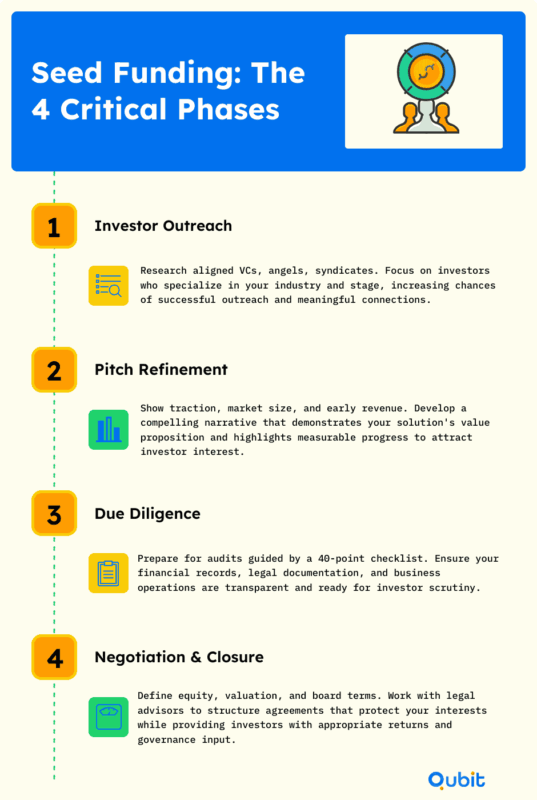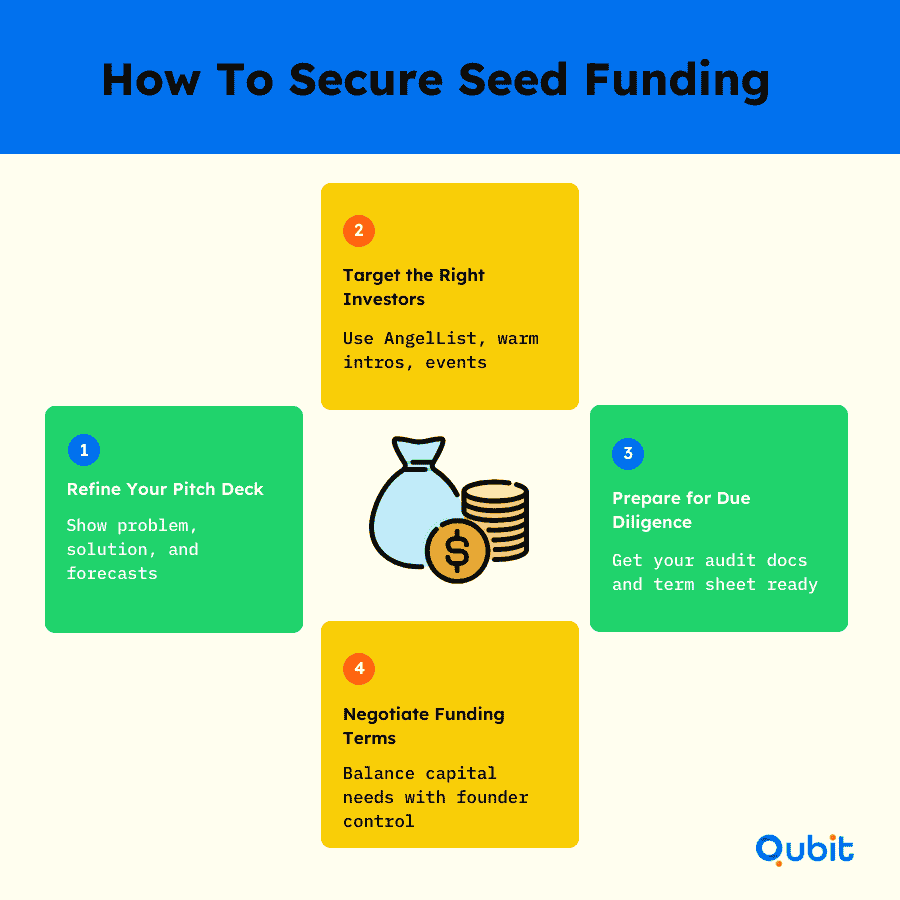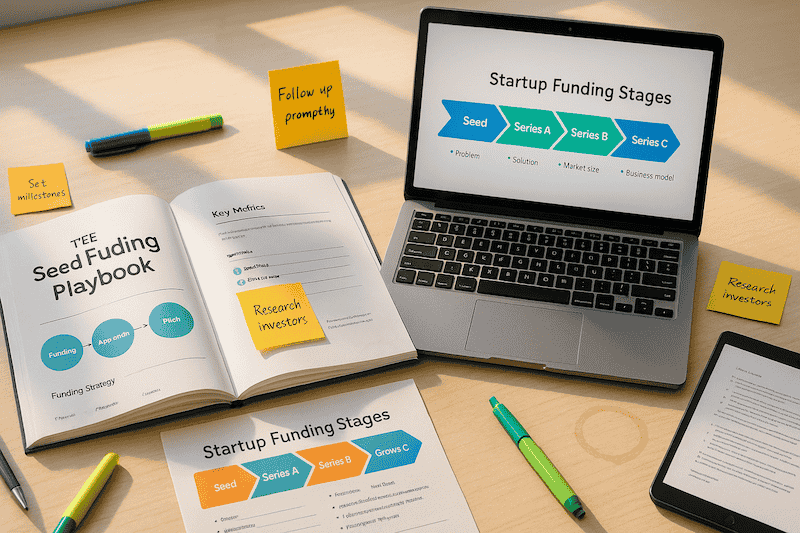Securing seed funding is a pivotal milestone for startups aiming to transform their ideas into scalable businesses. This initial round of financing provides the resources needed to develop a product, build a team, and establish market presence. However, the process can be daunting without a clear roadmap. Knowing the distinctions between seed funding vs angel investment can help founders choose the right financing strategy for their startup's unique needs.
This guide breaks down the essential steps on how to get seed funding, refine your pitch, and close the deal. Whether you're wondering what is a seed round or preparing to approach investors, this article equips you with actionable insights to navigate the funding landscape confidently.
What Does Seed Funding Look Like?
Securing seed funding is a pivotal milestone for startups aiming to scale and transition toward Series A. This stage not only provides the necessary capital but also validates a startup’s potential in the eyes of investors. Understanding the evolving dynamics of seed funding is crucial for founders, especially in a competitive financial environment marked by rising valuations and selective investor behavior.
Key Phases of Seed Funding
The seed funding process is multifaceted, requiring strategic planning and execution across several phases:

- Investor Outreach
Identifying the right investors is the first step. Founders must research venture capital firms, angel investors, and syndicates that align with their industry and vision. Tailored outreach efforts, supported by a compelling pitch deck, can significantly increase engagement. - Pitch Refinement
A well-crafted pitch is essential to capture investor interest. Beyond presenting the business model and market opportunity, founders should emphasize pre-seed revenue traction. This is increasingly important as investors now expect startups to demonstrate early financial performance, reflecting heightened risk aversion in the current climate. - Due Diligence
Investors conduct thorough evaluations before committing funds. Corporate audits, often guided by a 40-point checklist, play a critical role in this phase. These audits assess financial health, operational efficiency, and compliance, boosting investor confidence. - Negotiation and Deal Closure
Once due diligence is complete, founders negotiate terms such as equity stakes, board representation, and funding milestones. Clear communication and transparency are vital to ensure mutually beneficial agreements.
Current Trends Shaping Seed Funding
The seed funding landscape is undergoing significant shifts, driven by market trends and investor priorities.
- Rising Valuations
Median seed-stage valuations reached $14.8M in Q2 2024, marking an 11.3% increase over two quarters despite flat deal sizes. This growth signals heightened investor confidence but also raises the bar for startups seeking funding. - Selective Investor Behavior
Seed deal sizes now average $3.3M, reflecting a 35% year-over-year growth. However, fewer deals are being closed, highlighting a more selective approach by investors. Startups must refine their value propositions and demonstrate robust traction to stand out. - Higher Revenue Expectations at Pre-Seed
Investors increasingly require startups to show early revenue traction before entering the seed stage. This trend underscores the importance of strategic pre-seed planning. By exploring what is pre-seed funding, startups can gain early momentum and set a strong foundation for future growth. - Converging Seed and Series A Valuations
The narrowing gap between seed and Series A valuations is pushing startups to achieve faster growth and stronger traction. Founders must refine their strategies early to justify higher raises and meet overlapping funding milestones.
The Role of Corporate Audits
Corporate audits have emerged as a critical factor in the seed funding process. These audits, often guided by comprehensive checklists, provide investors with a clear picture of a startup’s operational and financial health. For founders, preparing for audits not only facilitates smoother due diligence but also strengthens their credibility in the eyes of potential investors. Grasping what is seed funding lays the groundwork for understanding the financial mechanisms that fuel early-stage startups.
Advanced Strategies for Success
From refining pitch decks to building strong investor relationships, strategic planning is key to navigating the complexities of seed funding.
Seed funding is more than just securing capital; it’s about laying the groundwork for sustainable growth and scalability. By understanding the current trends and preparing thoroughly for each phase, founders can position their startups for long-term success.
Actionable Steps for Securing Seed Funding
Securing seed funding is a pivotal milestone for startups, often determining their ability to scale and succeed. This section outlines practical steps to help founders attract early-stage investors, prepare for due diligence, and negotiate favorable funding terms. By following these strategies, startups can position themselves for success in the competitive world of seed funding.

1. Refine Your Pitch Deck
A well-crafted pitch deck is your startup’s first impression on potential investors. It should be concise, visually appealing, and backed by solid data.
- Highlight the problem and solution: Clearly articulate the problem your startup solves and how your product or service addresses it.
- Showcase market opportunity: Use compelling statistics to demonstrate the size and growth potential of your target market.
- Include financial projections: Present realistic revenue forecasts and explain how the seed funding will be utilized to achieve key milestones.
- Tell a story: Engage investors by weaving a narrative that connects your vision, mission, and goals.
Continuously refine your pitch deck based on feedback from mentors, advisors, and investors. For example, Airbnb’s pitch deck during its seed round in 2009 emphasized its unique value proposition and scalability, helping the company secure $600K in funding. This early capital enabled Airbnb to expand globally, eventually reaching a valuation of over $30 billion by 2024.
2. Target the Right Investors
Identifying and approaching the right investors can significantly increase your chances of securing seed funding for startups.
- Research investor profiles: Focus on investors who have a history of funding startups in your industry or niche.
- Attend pitch events: Participate in startup competitions and networking events to connect with angel investors and venture capitalists.
- Utilize digital platforms: Specialized platforms like AngelList and SeedInvest can help you reach investors actively seeking early-stage opportunities.
- Build relationships: Establish rapport with potential investors early on to foster trust and credibility.
Building relationships with seed investors can create long-lasting partnerships that drive your startup’s success.
3. Prepare for Rigorous Due Diligence
Investors will scrutinize every aspect of your business during the due diligence process. Preparing thoroughly can instill confidence and streamline the funding journey.
- Conduct a corporate audit: Ensure your legal, financial, and operational documents are organized and up-to-date.
- Draft a term sheet: Outline key funding terms, including equity distribution, valuation, and investor rights, to facilitate transparent negotiations.
- Address potential red flags: Identify and resolve any issues that could deter investors, such as unclear intellectual property ownership or inconsistent financial records.
4. Negotiate Funding Terms
Negotiating funding terms is a delicate process that requires a balance between securing capital and protecting your startup’s interests.
- Understand valuation: Be prepared to justify your startup’s valuation based on market trends, revenue potential, and competitive analysis.
- Focus on long-term goals: Ensure the terms align with your vision for growth and scalability.
- Seek expert advice: Consult with legal and financial advisors to navigate complex agreements and avoid unfavorable clauses.
Learning from successful startups can provide valuable insights. Oculus VR, for instance, secured $2.4M in seed capital funding in 2012 to develop its VR hardware prototype. The startup’s ability to negotiate favorable terms and deliver on its promises led to its acquisition by Facebook for $2B in 2014.
Real-World Examples: Lessons from Airbnb and Oculus VR
Case studies of successful startups illustrate the transformative impact of seed funding.
- Airbnb: The $600K seed round in 2009 enabled Airbnb to scale its operations and establish a global marketplace.
- Oculus VR: Early-stage funding of $2.4M helped Oculus VR develop its prototype, ultimately leading to a billion-dollar acquisition.
These examples underscore the importance of securing seed funding to fuel innovation and growth.
Ready to connect with the right investors? Explore our Investor Outreach services to kickstart your seed funding journey.
Cultivating Investor Relationships for Long-Term Success
Building solid, long-term relationships with investors is key to a company's continued growth and stability. It isn’t just about securing initial funding—it’s about nurturing ongoing trust and communication.
Here are some strategies to cultivate strong investor relationships:
- Maintain regular communication with investors, providing updates on both successes and challenges.
- Be transparent about your company's progress and long-term vision.
- Show appreciation for their support through acknowledgment and thanks.
- Actively engage in problem-solving with investors during difficult times.
Forging Strong Investor Partnerships for Long-Term Growth
Building trust with early‑stage backers goes beyond a single pitch. You want investors who believe in your vision and will support you through ups and downs. Start by researching potential partners deeply—know their past deals, values and the kinds of founders they back. When you make first contact, be genuine: explain why you see them as a fit and ask for a short call rather than a full presentation.
Keep these steps in mind as you cultivate relationships:
- Research investor backgrounds and portfolio highlights
- Reach out with a brief, personalized message or warm introduction
- Provide regular, concise updates on milestones and challenges
- Invite feedback on product direction or go‑to‑market plans
- Show appreciation by acknowledging their time and insights
Strong partnerships bring more than money. You gain mentors who help sharpen your strategy, open doors to new networks and offer guidance when obstacles arise. When you share progress and setbacks in a clear, honest way, backers feel more invested in your journey.
Ultimately, building these connections takes consistent effort. Schedule informal check‑ins, ask thoughtful questions and act on feedback. By treating investors as collaborators—not just funders—you lay the groundwork for lasting support and shared success.
Conclusion
Securing startup funding is a journey that requires both strategy and preparation. Throughout this blog, we’ve explored actionable insights, including the importance of crafting a compelling pitch deck and practicing your presentation to align with investor expectations. A clear narrative combined with thorough preparation can significantly enhance your chances of success.
Understanding the types of startup funding is critical for determining the most suitable approach for your business goals and growth stage. Whether you're seeking seed funding or exploring other options, positioning your business effectively within the broader funding landscape is essential.
If you're looking to secure the capital you need to grow, we at Qubit Capital are here to help. Check out our Fundraising Assistance service today. Let’s take your funding journey to the next level together!
Key Takeaways
- A systematic, step-by-step approach is vital from pitch deck creation to closing the funding deal.
- Current market data shows rising seed-stage valuations and a selective investor environment.
- Conducting thorough corporate audits can streamline due diligence and build investor confidence.
- Real-life examples like Airbnb and Oculus VR underscore the transformative power of early seed funding.
Frequently asked Questions
How to reach seed funding?
Securing seed funding requires a well-prepared pitch deck, identifying the right investors, and thorough readiness for due diligence. Key steps include refining your pitch to highlight your business’s unique value, targeting investors whose interests align with your industry, and negotiating terms effectively.


 Back
Back



